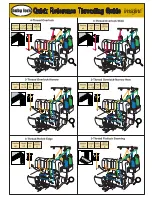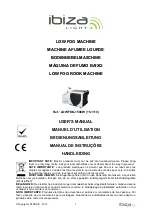
5-10
2) Upper Thread Tension Adjustment
①
The upper thread tension is controlled by the
sub and main thread tension adjusters. Turn
clockwise to increase the tension and
counterclockwise to decrease the tension.
②
The sub-tension adjusters should control about
2/3 of the thread tension while the main
adjuster should handle the other 1/3. Set the
sub-tension adjuster so the upper thread flows
smoothly through the rotary tension disks and
into the rollers of the main tension adjuster.
Thread tension adjustment is critical for producing high quality of the embroidery. A balance of 2/3 upper
thread and 1/3 lower thread generally indicates good tension. If the tension is too loose, the upper thread
will loop, causing thread tangles or breaks. If the tension is too tight, puckering may occur as well as
thread and needle breaks.
[Fig.5-11]
Threading the sub
tension adjuster
Threading the main
tension adjuster
Threading the thread
detector roller
Threading around the
needle
Wrap the thread 1.5 times
around the rotary tension
disk (V-shaped groove.)
Wrap the thread clockwise
around the thread guide
disk.
Wrap the thread around
the detector roller one
time.
Fix the upper thread
between the thread holder
spring of the lower thread
guide.
Thread Guide Disk
(Pass through the
middle of shaft)
Thread Sensing
Roller
One turn
Rotary Tension Disk
Thread holder
spring
Thread guide
(lower)
Adjusting nut
Main
tension
adjuster
[Fig.5-12]
[CAUTION]
�
If tension at the sub adjuster is too loose,
the detector roller may not rotate well and
make wrong detections.
�
After adjusting the tension, check if the
upper thread tension is what can be
pulled with little force of around 100-120g.
[CAUTION]
�
After adjusting the tension, pull the upper
thread to see if the detector roller rotates
well.
�
Adjust the tension according to the type
of thread and fabric used.
Sub-tension
adjuster
One and
half turn
















































